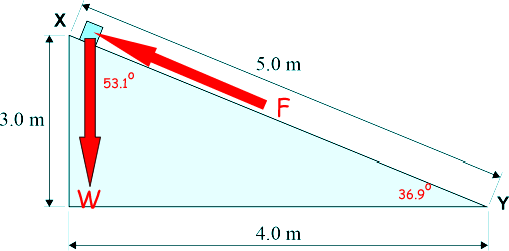Newton's Laws Q1. The mass of fuel in a racing car decreases during a race. As a result the lap time decreases. Which of the following could explain this decrease?
F= ma - therefore the force from the engine will produce greater acceleration and deceleration.
Q2. What is represented by the area under a force–displacement graph?
Work done is force x distance moved (units Nm)
Q3. Which of the following is not a unit of power?
That is a quick one to answer - but here goes the other choices:
Q4. In a test a 500 kg car travelling at 10 m s–1 hits a wall. The front 0.30 m of the car crumples as the car is brought to rest. What is the average force on the car during the impact?
m = 500 kg F = ma a = ? s = 0.30 v = 0 m/s u = 10 m/s v2 = u2 + 2as 02 = 102 + 2a x 0.30 0 = 100 + 0.60a a = -100/0.60 = -167 m/s2 F = 500 x (-167) = 83,333 N F = 83 kN Therefore choice D is correct Q5. A rocket has a mass of 12,000 kg. It accelerates vertically upwards from the surface of the Earth at 1.4 m s−2. What is the thrust of the rocket?
T = ma + mg T = 12,000 (1.4 + 9.81) T = 1.2 x 104 x 11.21 T = 1.39 x 105 N Q6. What is a correct unit for the area under a force−time graph?
But we know that F=ma
Therefore Ft units must be kg m s-2s = kg m s-1 Q7. A mass of 2.5 kg is released from rest at X and slides down a ramp, of height 3.0 m, to point Y as shown.
When the mass reaches Y at the bottom of the ramp it has a velocity of 5.0 ms–1 . What is the average frictional force between the mass and the ramp?
The component of weight acting down the slope is W cos 53.1o This is opposed by friction The net force of (W cos 53.1o - F) results in a final velocity of 5 m/s v = 5 m/s s = 5 m u = 0 m/s a = ? v2 = u2 + 2 as 25 = 10 a a = 2.5 m/s2 This acceleration is caused by the net force of W cos 53.1o - F Now, F = ma and W = mg mg cos 53.1o - F = 2.5m F = mg cos 53.1o - 2.5m F = 2.5 (gcos 53.1o - 2.5) F = 8.5 N Choice A Q8. Two bodies of different masses undergo an elastic collision in the absence of any external force. Which row gives the effect on the total kinetic energy of the masses and the magnitudes of the forces exerted on the masses during the collision?
Choice A |
Follow me...
|






